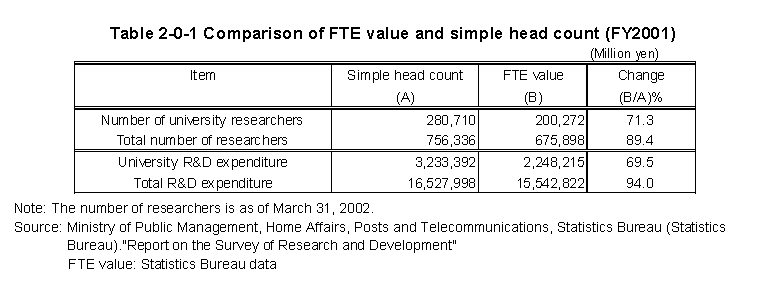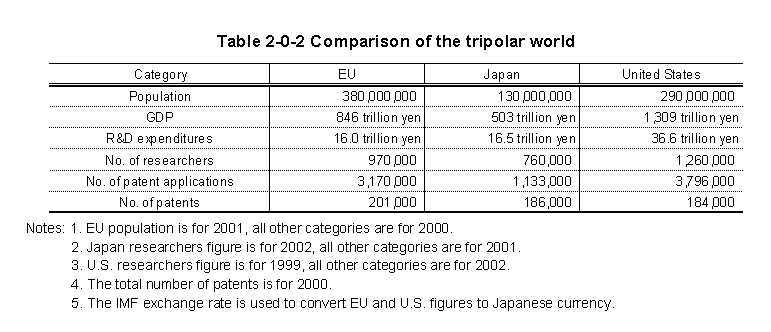| Home > Policy > White Paper, Notice, Announcement > White Paper > WHITE PAPER ON SCIENCE AND TECHNOLOGY2003 > Part2 | ||
The leading advanced nations are reacting to economic globalization and to the attendant intensification of competition in the global economy,and to the increased importance of energy,food,global environmental problems,and other global and pan human issues by aggressively promoting science and technology policies towards the assurance of competitive strengths and employment,and towards the resolution of global and pan human issues.
In Japan,despite a year-on-year decline in gross domestic product(GDP)for FY2001,R&D exdependiture witnessed an increase for the second consecutive year due to big increases among private-sector enterprises.Although the number of researchers in FY2002 took an upturn year-on-year,R&D personnel on the whole,including research support staff and technicians,witnessed the fourth consecutive year of declines.
As can be seen,the human and capital resources that are foundations for Japan's science and technology have been forced into retreat by Japan's prolonged economic stagnation.This retreat should cause for concern for Japan that aims to become"a nation based on creativity of science and technology."If Japan is to continue in the future to enhance the international competitive power,to improve the quality of the people's lives,and also to respond to global and pan human issues,Japan must further strengthen and expand research and development activities while taking due consideration of the severe fiscal situation.
Part2will compare Japan and major countries in the areas pertaining to science and technology,such as research expenditures and number of researchers,so as to highlight the special characteristics of Japan's science and technology activities.This information will then be used for a more indepth analysis of the trends in Japan's research activities. 1)
| International Comparisons of Science and Technology Indicators |
A prerequisite for making international comparisons of statistical data is to examine the subject statistical data from each country based on unified standards.The Organisation for Economic Co-operation and Development(OECD)has prepared the Frascati Manual 2) as a guideline for the collection and analysis of data related to scientific and technological activities,and has asked member countries to base their science and technology indicators on that manual.
In the Frascati Manual,the method for calculating the number of researchers is derived from two types of data-a simple head count of the number of researchers,and a full-time equivalent(FTE)value 3) ,which takes into consideration the proportion of time actually devoted to research activities.The latter is touted in the Manual as being a proper quantitative method for measuring research personnel resources,and all OECD member countries are called upon to support the FTE value.
In Japan,a conversion of various elements has been used to arrive at a number representing the number of full-time researchers,using the"full-time equivalent ratio"estimated from the results of a survey targeting instructors at universities and colleges taken in1992by the Statistics Bureau of the Ministry of Public Management,Home Affairs,Posts and Telecommunications,and the number of researchers and amount of research expenses at universities and colleges from a2002survey of research and development (Table2-0-1) .The FTE differs from the simple head count especially in the case of researchers at universities and colleges,who are also engaged in teaching activities,and thus,this also changes the corresponding amount of research expenses used at universities and colleges.
In Part2,we shall use both the simple head count and the FTE value when we make inter-national comparisons of researcher numbers and R&D expenditure for recent years.
Note1)In Part2,"research activities"apply principally to natural sciences.Cases which involve humanities or social sciences will be annotated.Classification of natural sciences as distinct from social sciences and humanities is based on the individual research institute or university and college department concerned.
Note2)Frascati Manual:A manual for proper international comparisons of R&D statistics.The original proposal for the first edition of this manual was made at a meeting in Frascati,Italy,in1963,and the manual was completed after discussions and revisions by experts of OECD member countries.Operations to revise the manual are currently underway.The sixth edition was published in December2002.
Note3)FTE value:FTE is an abbreviation of Full Time Equivalent,and is a converted value showing the actual time engaged in research.If a re-searcher has an average of30%of his/her working hours allocated to research and development operations and is engaged in other activities(teaching,university administration,student counseling,etc.),he/she is said to have a0.3FTE.In the same way,a full-time researcher employed for only six months in research and development work is said to have a0.5FTE.

| Research and Development in the European Union |
The Treaty on European Union(commonly known as the Maastricht Treaty)was signed in1992,and the European Union(EU)was established.The next step in this development was introduction of a common currency in January1999,which was followed three years later,in January2002,with the circulation of Euro-denominated coins and bills in member states.Now,ten central and eastern European countries have been granted membership in the EU for2004.
The EU has demonstrated its important presence in recent years in many arenas on the international stage,rapidly establishing its position as a global player.In terms of science and technology indicators,the EU is second only to the United States.In the future,Japan should not fail to ensure a good relationship with the EU so that Japan can enhance its international competitive strength (Table2-0-2)
The basic objectives of the EU science and technology policy are"strengthening the scientific and technological basis of Community industry and encouraging it to become more competitive at an international level,while promoting all the re-search activities deemed necessary by virtue of other Chapters of this Treaty"(Treaty Establishing the European Community).Based on these objecttives,the Framework Programme(Sixth Frame-work Programme(FP6),from2002to2006,now in progress)showing the basic framework for research and development activities in the EU was adopted.
While the EU is not targeted by the international comparisons in this part of this publication,because it is not a nation but rather a community of nation states,indicators for the EU have been included in these comparisons in Part2wherever possible,as totals of science and technology indicators 4) for EU countries.

Note4)EU science and technology indicators:The EU science and technology indicators used in Part2utilize research expenses drawn from data reported by Eurostat(European Commission Statistics Bureau),number of researchers from data reported by the OECD,and number of patent applications and registrations from WIPO(World Intellectual Property Organization)data.
| Back to Top | MEXT HOME |